Assessing and Measuring Quality Work of Employees: A Management Report
VerifiedAdded on 2022/08/17
|9
|1882
|11
Report
AI Summary
This report delves into the critical concept of quality work within an organizational context, emphasizing its significance in achieving desired performance standards and fostering a positive work environment. It explores various factors contributing to quality work, including safe and effective job performance, timely execution of responsibilities, and minimizing errors. The report introduces the Behavioral Anchored Rating Scale (BARS) as a tool for measuring employee performance, focusing on dimensions such as time management and tardiness. It outlines a 5-point rating scale, providing detailed criteria for assessing employees' competence in these areas. The report also discusses the application of the BARS, including the scoring procedure, target outcomes, and potential consequences for highly appraised employees. The report emphasizes the importance of clear standards and objective feedback in employee evaluations, contributing to improved organizational performance. The report concludes with a discussion of the benefits and potential consequences of using the BARS system for employee assessment, highlighting the impact on employee motivation and organizational success. The report is a valuable resource for understanding and implementing effective performance management strategies.
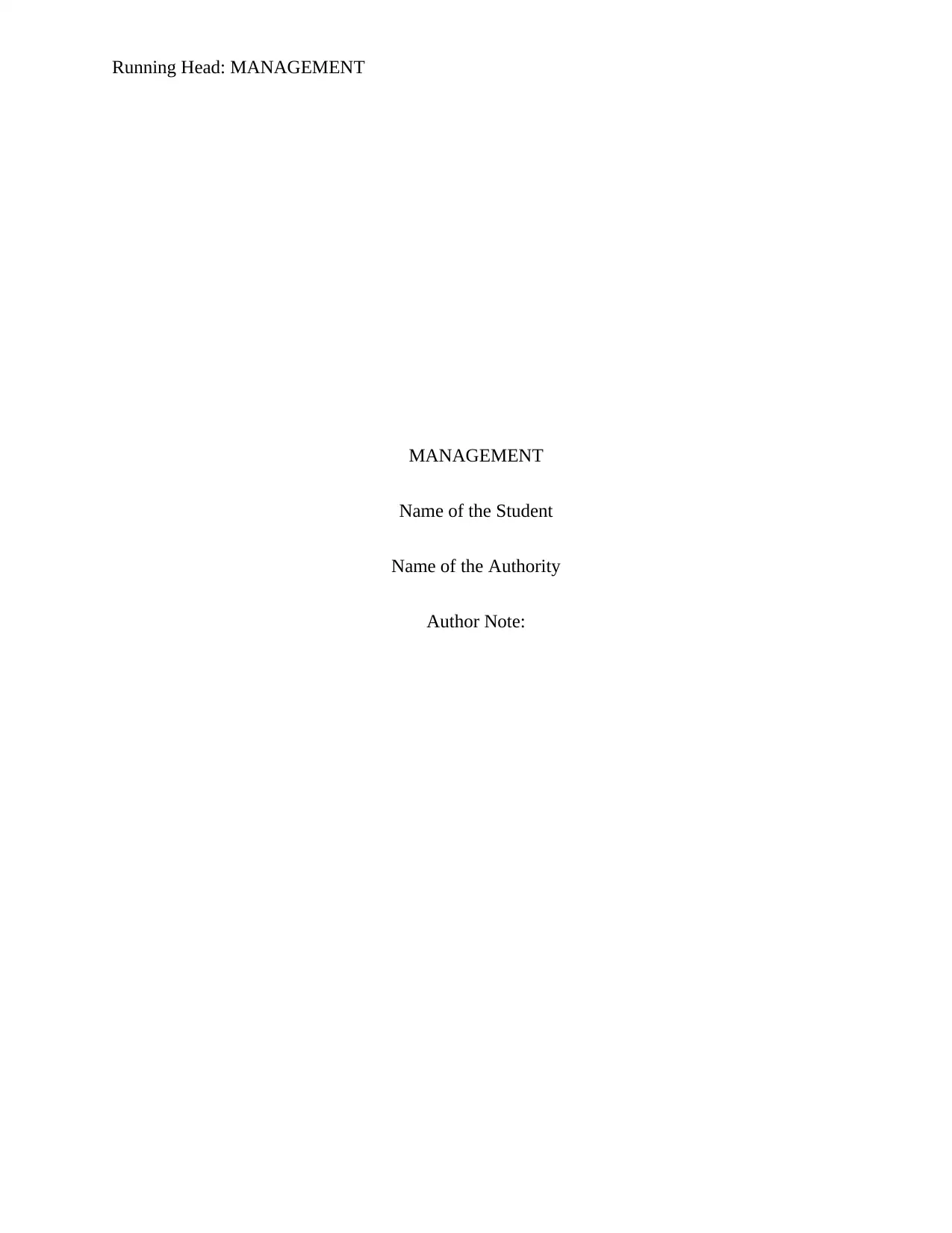
Running Head: MANAGEMENT
MANAGEMENT
Name of the Student
Name of the Authority
Author Note:
MANAGEMENT
Name of the Student
Name of the Authority
Author Note:
Paraphrase This Document
Need a fresh take? Get an instant paraphrase of this document with our AI Paraphraser
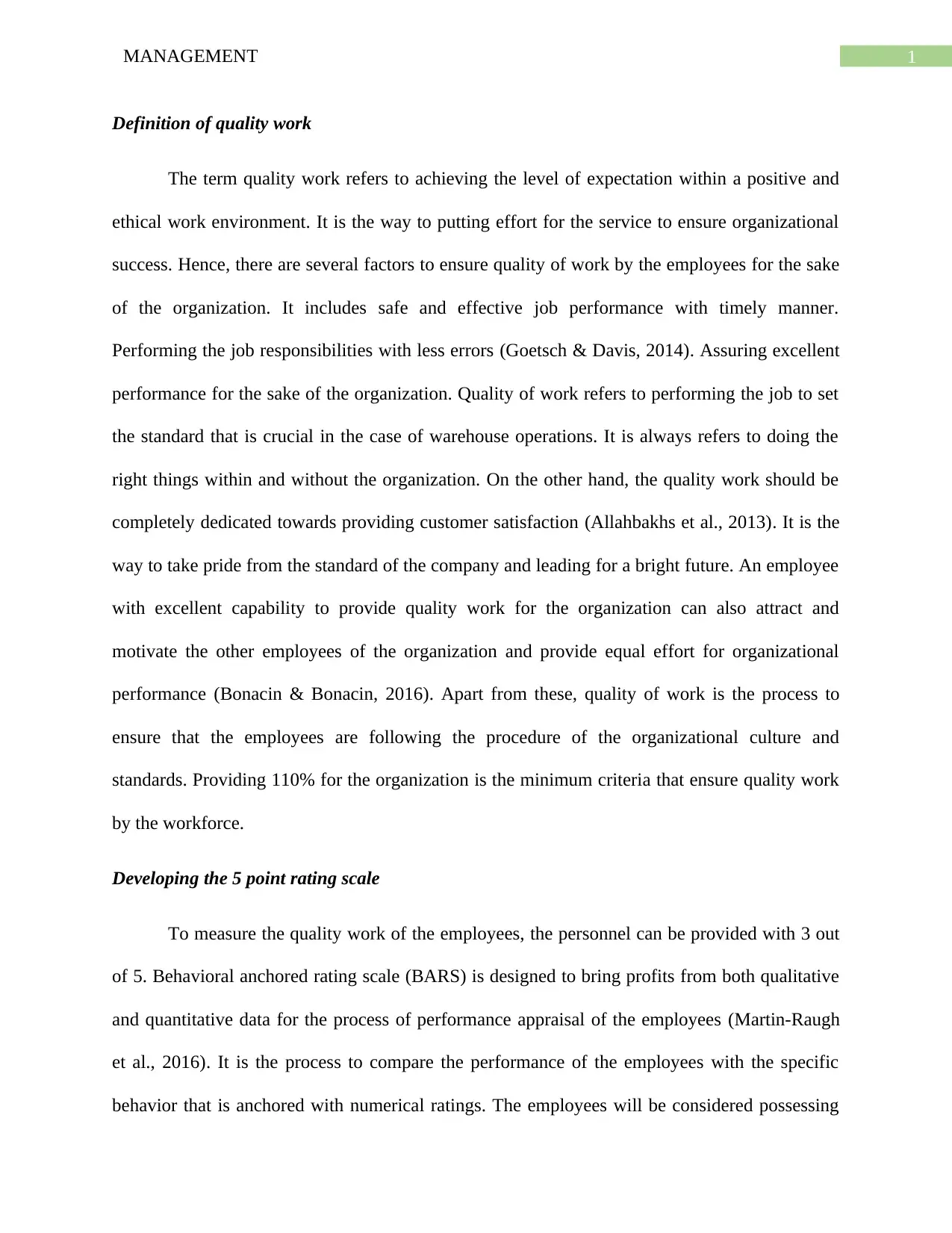
1MANAGEMENT
Definition of quality work
The term quality work refers to achieving the level of expectation within a positive and
ethical work environment. It is the way to putting effort for the service to ensure organizational
success. Hence, there are several factors to ensure quality of work by the employees for the sake
of the organization. It includes safe and effective job performance with timely manner.
Performing the job responsibilities with less errors (Goetsch & Davis, 2014). Assuring excellent
performance for the sake of the organization. Quality of work refers to performing the job to set
the standard that is crucial in the case of warehouse operations. It is always refers to doing the
right things within and without the organization. On the other hand, the quality work should be
completely dedicated towards providing customer satisfaction (Allahbakhs et al., 2013). It is the
way to take pride from the standard of the company and leading for a bright future. An employee
with excellent capability to provide quality work for the organization can also attract and
motivate the other employees of the organization and provide equal effort for organizational
performance (Bonacin & Bonacin, 2016). Apart from these, quality of work is the process to
ensure that the employees are following the procedure of the organizational culture and
standards. Providing 110% for the organization is the minimum criteria that ensure quality work
by the workforce.
Developing the 5 point rating scale
To measure the quality work of the employees, the personnel can be provided with 3 out
of 5. Behavioral anchored rating scale (BARS) is designed to bring profits from both qualitative
and quantitative data for the process of performance appraisal of the employees (Martin-Raugh
et al., 2016). It is the process to compare the performance of the employees with the specific
behavior that is anchored with numerical ratings. The employees will be considered possessing
Definition of quality work
The term quality work refers to achieving the level of expectation within a positive and
ethical work environment. It is the way to putting effort for the service to ensure organizational
success. Hence, there are several factors to ensure quality of work by the employees for the sake
of the organization. It includes safe and effective job performance with timely manner.
Performing the job responsibilities with less errors (Goetsch & Davis, 2014). Assuring excellent
performance for the sake of the organization. Quality of work refers to performing the job to set
the standard that is crucial in the case of warehouse operations. It is always refers to doing the
right things within and without the organization. On the other hand, the quality work should be
completely dedicated towards providing customer satisfaction (Allahbakhs et al., 2013). It is the
way to take pride from the standard of the company and leading for a bright future. An employee
with excellent capability to provide quality work for the organization can also attract and
motivate the other employees of the organization and provide equal effort for organizational
performance (Bonacin & Bonacin, 2016). Apart from these, quality of work is the process to
ensure that the employees are following the procedure of the organizational culture and
standards. Providing 110% for the organization is the minimum criteria that ensure quality work
by the workforce.
Developing the 5 point rating scale
To measure the quality work of the employees, the personnel can be provided with 3 out
of 5. Behavioral anchored rating scale (BARS) is designed to bring profits from both qualitative
and quantitative data for the process of performance appraisal of the employees (Martin-Raugh
et al., 2016). It is the process to compare the performance of the employees with the specific
behavior that is anchored with numerical ratings. The employees will be considered possessing
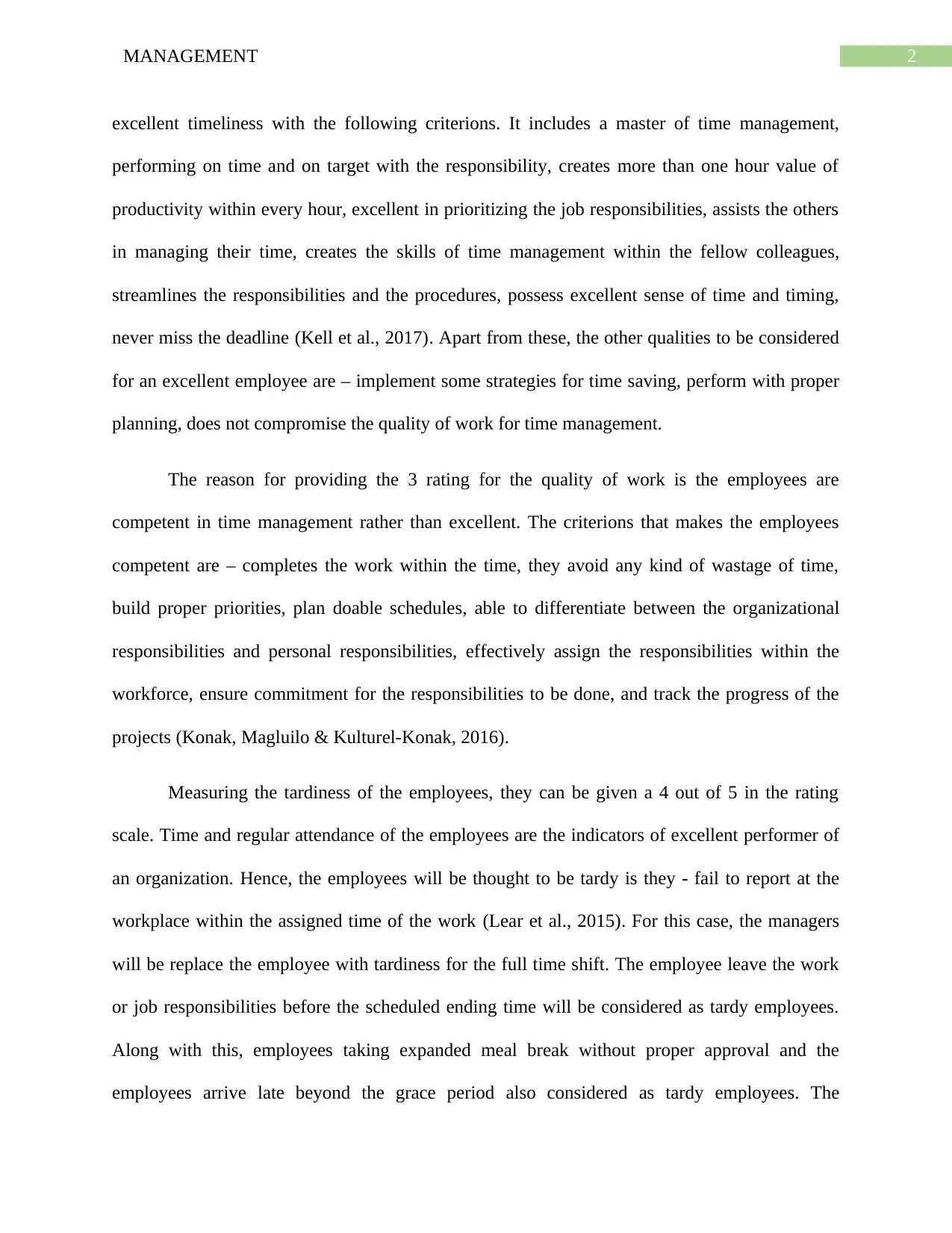
2MANAGEMENT
excellent timeliness with the following criterions. It includes a master of time management,
performing on time and on target with the responsibility, creates more than one hour value of
productivity within every hour, excellent in prioritizing the job responsibilities, assists the others
in managing their time, creates the skills of time management within the fellow colleagues,
streamlines the responsibilities and the procedures, possess excellent sense of time and timing,
never miss the deadline (Kell et al., 2017). Apart from these, the other qualities to be considered
for an excellent employee are – implement some strategies for time saving, perform with proper
planning, does not compromise the quality of work for time management.
The reason for providing the 3 rating for the quality of work is the employees are
competent in time management rather than excellent. The criterions that makes the employees
competent are – completes the work within the time, they avoid any kind of wastage of time,
build proper priorities, plan doable schedules, able to differentiate between the organizational
responsibilities and personal responsibilities, effectively assign the responsibilities within the
workforce, ensure commitment for the responsibilities to be done, and track the progress of the
projects (Konak, Magluilo & Kulturel-Konak, 2016).
Measuring the tardiness of the employees, they can be given a 4 out of 5 in the rating
scale. Time and regular attendance of the employees are the indicators of excellent performer of
an organization. Hence, the employees will be thought to be tardy is they - fail to report at the
workplace within the assigned time of the work (Lear et al., 2015). For this case, the managers
will be replace the employee with tardiness for the full time shift. The employee leave the work
or job responsibilities before the scheduled ending time will be considered as tardy employees.
Along with this, employees taking expanded meal break without proper approval and the
employees arrive late beyond the grace period also considered as tardy employees. The
excellent timeliness with the following criterions. It includes a master of time management,
performing on time and on target with the responsibility, creates more than one hour value of
productivity within every hour, excellent in prioritizing the job responsibilities, assists the others
in managing their time, creates the skills of time management within the fellow colleagues,
streamlines the responsibilities and the procedures, possess excellent sense of time and timing,
never miss the deadline (Kell et al., 2017). Apart from these, the other qualities to be considered
for an excellent employee are – implement some strategies for time saving, perform with proper
planning, does not compromise the quality of work for time management.
The reason for providing the 3 rating for the quality of work is the employees are
competent in time management rather than excellent. The criterions that makes the employees
competent are – completes the work within the time, they avoid any kind of wastage of time,
build proper priorities, plan doable schedules, able to differentiate between the organizational
responsibilities and personal responsibilities, effectively assign the responsibilities within the
workforce, ensure commitment for the responsibilities to be done, and track the progress of the
projects (Konak, Magluilo & Kulturel-Konak, 2016).
Measuring the tardiness of the employees, they can be given a 4 out of 5 in the rating
scale. Time and regular attendance of the employees are the indicators of excellent performer of
an organization. Hence, the employees will be thought to be tardy is they - fail to report at the
workplace within the assigned time of the work (Lear et al., 2015). For this case, the managers
will be replace the employee with tardiness for the full time shift. The employee leave the work
or job responsibilities before the scheduled ending time will be considered as tardy employees.
Along with this, employees taking expanded meal break without proper approval and the
employees arrive late beyond the grace period also considered as tardy employees. The
⊘ This is a preview!⊘
Do you want full access?
Subscribe today to unlock all pages.

Trusted by 1+ million students worldwide
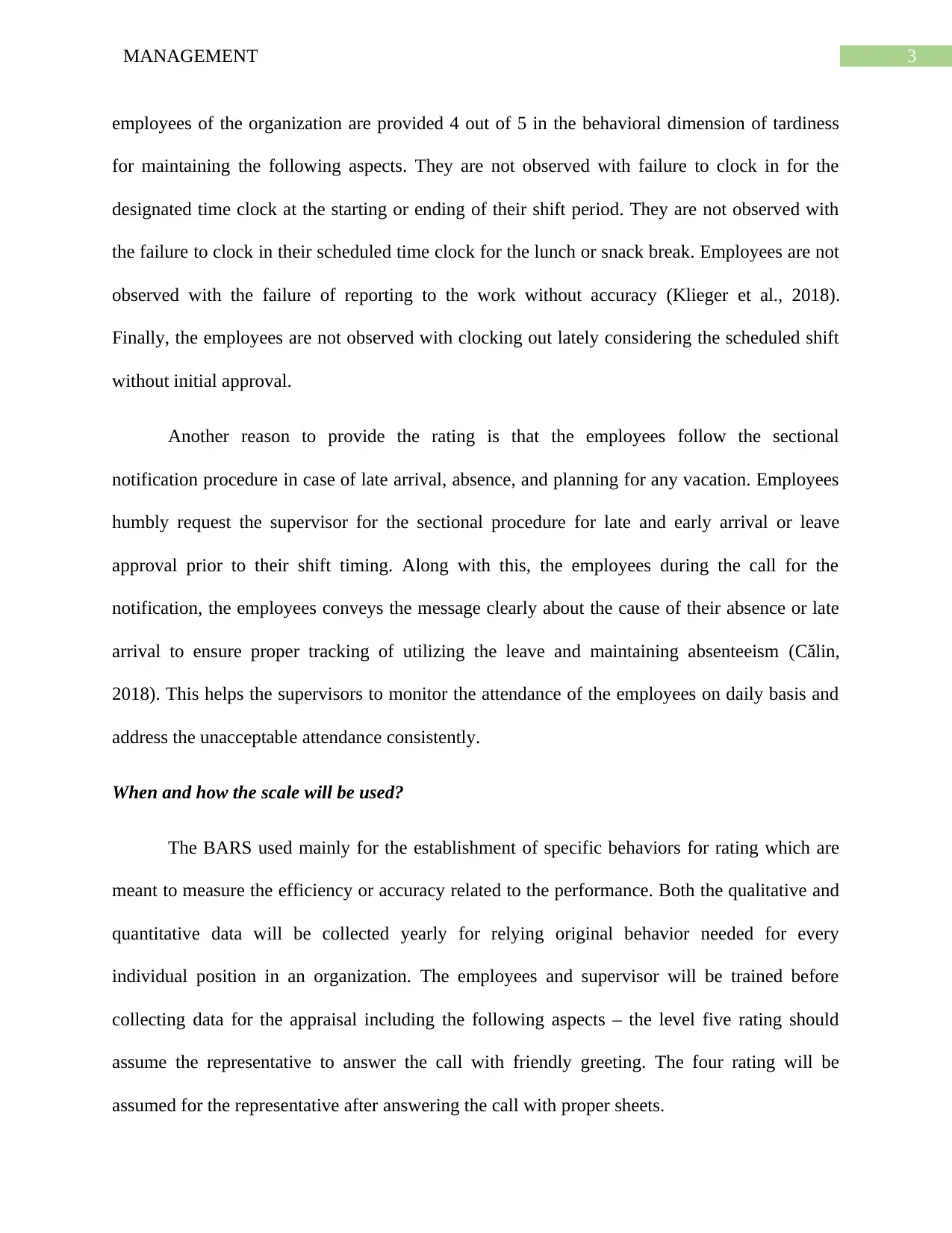
3MANAGEMENT
employees of the organization are provided 4 out of 5 in the behavioral dimension of tardiness
for maintaining the following aspects. They are not observed with failure to clock in for the
designated time clock at the starting or ending of their shift period. They are not observed with
the failure to clock in their scheduled time clock for the lunch or snack break. Employees are not
observed with the failure of reporting to the work without accuracy (Klieger et al., 2018).
Finally, the employees are not observed with clocking out lately considering the scheduled shift
without initial approval.
Another reason to provide the rating is that the employees follow the sectional
notification procedure in case of late arrival, absence, and planning for any vacation. Employees
humbly request the supervisor for the sectional procedure for late and early arrival or leave
approval prior to their shift timing. Along with this, the employees during the call for the
notification, the employees conveys the message clearly about the cause of their absence or late
arrival to ensure proper tracking of utilizing the leave and maintaining absenteeism (Călin,
2018). This helps the supervisors to monitor the attendance of the employees on daily basis and
address the unacceptable attendance consistently.
When and how the scale will be used?
The BARS used mainly for the establishment of specific behaviors for rating which are
meant to measure the efficiency or accuracy related to the performance. Both the qualitative and
quantitative data will be collected yearly for relying original behavior needed for every
individual position in an organization. The employees and supervisor will be trained before
collecting data for the appraisal including the following aspects – the level five rating should
assume the representative to answer the call with friendly greeting. The four rating will be
assumed for the representative after answering the call with proper sheets.
employees of the organization are provided 4 out of 5 in the behavioral dimension of tardiness
for maintaining the following aspects. They are not observed with failure to clock in for the
designated time clock at the starting or ending of their shift period. They are not observed with
the failure to clock in their scheduled time clock for the lunch or snack break. Employees are not
observed with the failure of reporting to the work without accuracy (Klieger et al., 2018).
Finally, the employees are not observed with clocking out lately considering the scheduled shift
without initial approval.
Another reason to provide the rating is that the employees follow the sectional
notification procedure in case of late arrival, absence, and planning for any vacation. Employees
humbly request the supervisor for the sectional procedure for late and early arrival or leave
approval prior to their shift timing. Along with this, the employees during the call for the
notification, the employees conveys the message clearly about the cause of their absence or late
arrival to ensure proper tracking of utilizing the leave and maintaining absenteeism (Călin,
2018). This helps the supervisors to monitor the attendance of the employees on daily basis and
address the unacceptable attendance consistently.
When and how the scale will be used?
The BARS used mainly for the establishment of specific behaviors for rating which are
meant to measure the efficiency or accuracy related to the performance. Both the qualitative and
quantitative data will be collected yearly for relying original behavior needed for every
individual position in an organization. The employees and supervisor will be trained before
collecting data for the appraisal including the following aspects – the level five rating should
assume the representative to answer the call with friendly greeting. The four rating will be
assumed for the representative after answering the call with proper sheets.
Paraphrase This Document
Need a fresh take? Get an instant paraphrase of this document with our AI Paraphraser
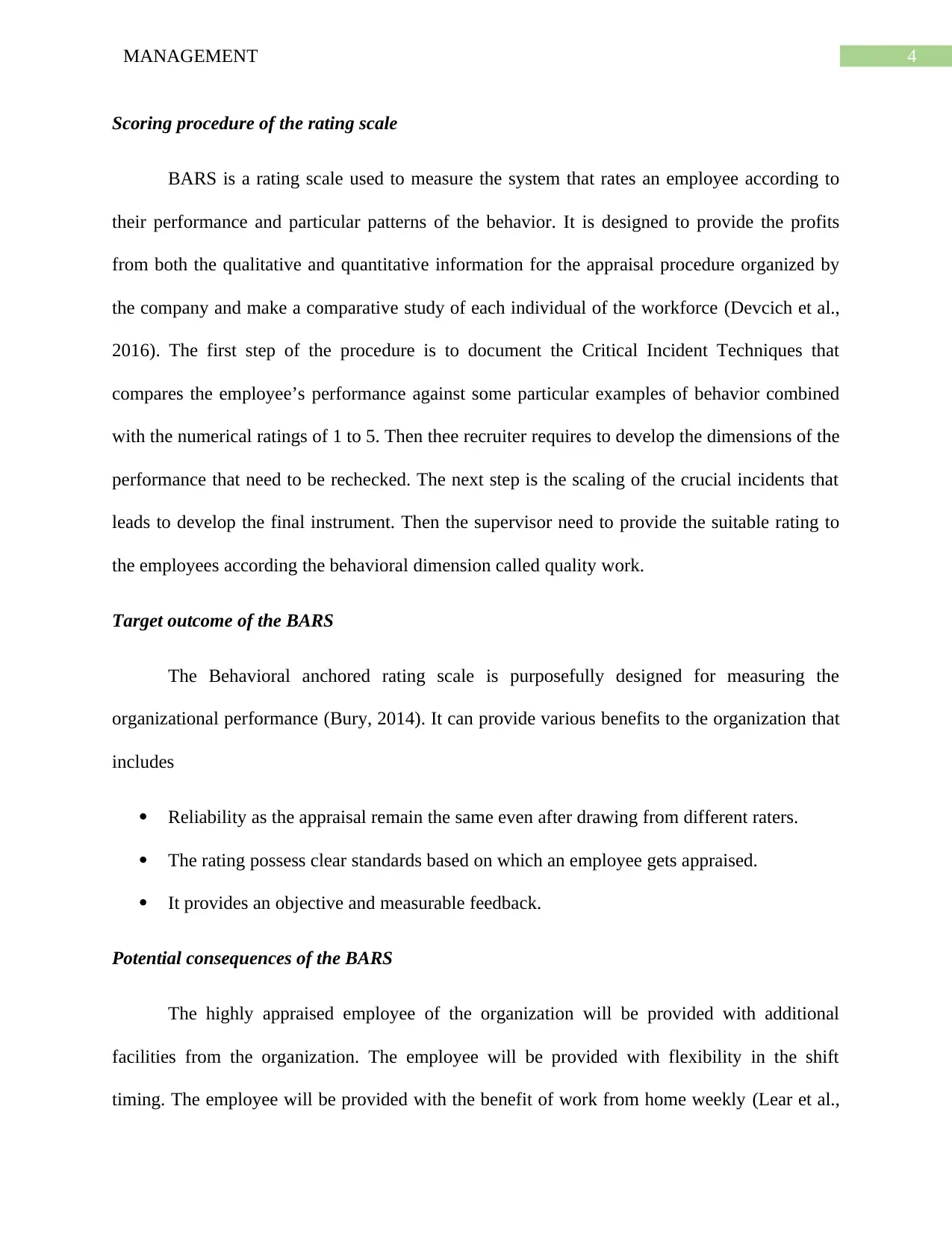
4MANAGEMENT
Scoring procedure of the rating scale
BARS is a rating scale used to measure the system that rates an employee according to
their performance and particular patterns of the behavior. It is designed to provide the profits
from both the qualitative and quantitative information for the appraisal procedure organized by
the company and make a comparative study of each individual of the workforce (Devcich et al.,
2016). The first step of the procedure is to document the Critical Incident Techniques that
compares the employee’s performance against some particular examples of behavior combined
with the numerical ratings of 1 to 5. Then thee recruiter requires to develop the dimensions of the
performance that need to be rechecked. The next step is the scaling of the crucial incidents that
leads to develop the final instrument. Then the supervisor need to provide the suitable rating to
the employees according the behavioral dimension called quality work.
Target outcome of the BARS
The Behavioral anchored rating scale is purposefully designed for measuring the
organizational performance (Bury, 2014). It can provide various benefits to the organization that
includes
Reliability as the appraisal remain the same even after drawing from different raters.
The rating possess clear standards based on which an employee gets appraised.
It provides an objective and measurable feedback.
Potential consequences of the BARS
The highly appraised employee of the organization will be provided with additional
facilities from the organization. The employee will be provided with flexibility in the shift
timing. The employee will be provided with the benefit of work from home weekly (Lear et al.,
Scoring procedure of the rating scale
BARS is a rating scale used to measure the system that rates an employee according to
their performance and particular patterns of the behavior. It is designed to provide the profits
from both the qualitative and quantitative information for the appraisal procedure organized by
the company and make a comparative study of each individual of the workforce (Devcich et al.,
2016). The first step of the procedure is to document the Critical Incident Techniques that
compares the employee’s performance against some particular examples of behavior combined
with the numerical ratings of 1 to 5. Then thee recruiter requires to develop the dimensions of the
performance that need to be rechecked. The next step is the scaling of the crucial incidents that
leads to develop the final instrument. Then the supervisor need to provide the suitable rating to
the employees according the behavioral dimension called quality work.
Target outcome of the BARS
The Behavioral anchored rating scale is purposefully designed for measuring the
organizational performance (Bury, 2014). It can provide various benefits to the organization that
includes
Reliability as the appraisal remain the same even after drawing from different raters.
The rating possess clear standards based on which an employee gets appraised.
It provides an objective and measurable feedback.
Potential consequences of the BARS
The highly appraised employee of the organization will be provided with additional
facilities from the organization. The employee will be provided with flexibility in the shift
timing. The employee will be provided with the benefit of work from home weekly (Lear et al.,
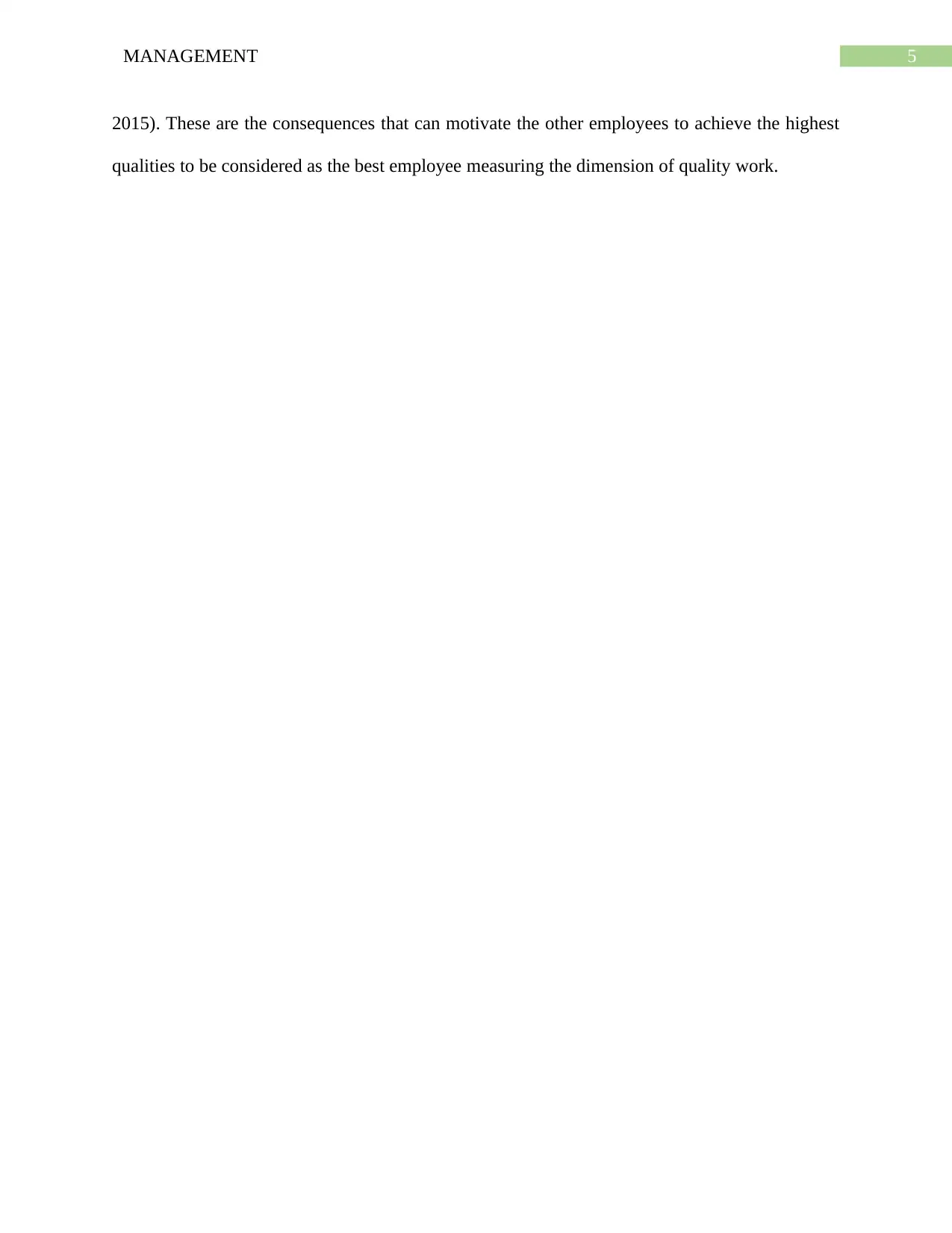
5MANAGEMENT
2015). These are the consequences that can motivate the other employees to achieve the highest
qualities to be considered as the best employee measuring the dimension of quality work.
2015). These are the consequences that can motivate the other employees to achieve the highest
qualities to be considered as the best employee measuring the dimension of quality work.
⊘ This is a preview!⊘
Do you want full access?
Subscribe today to unlock all pages.

Trusted by 1+ million students worldwide
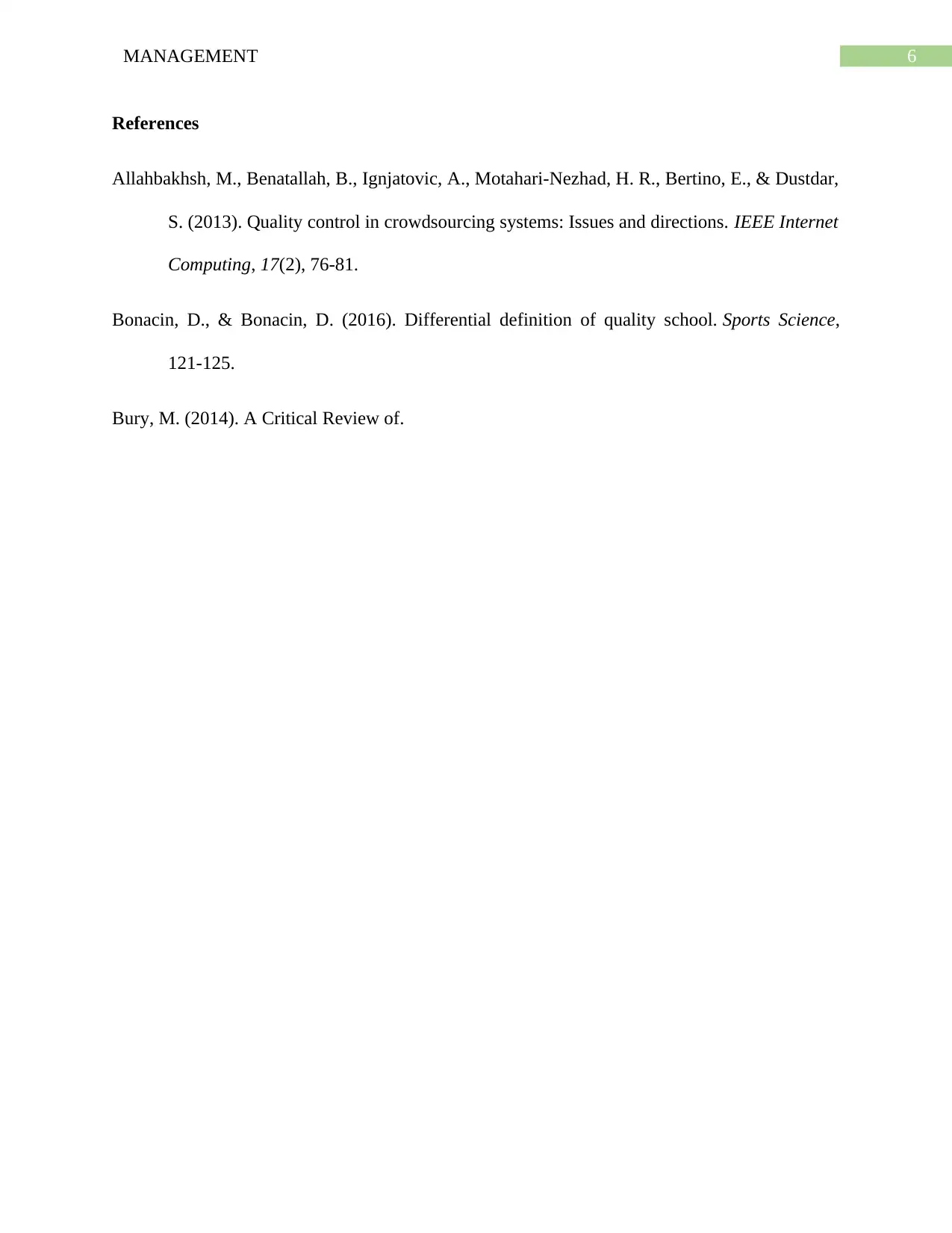
6MANAGEMENT
References
Allahbakhsh, M., Benatallah, B., Ignjatovic, A., Motahari-Nezhad, H. R., Bertino, E., & Dustdar,
S. (2013). Quality control in crowdsourcing systems: Issues and directions. IEEE Internet
Computing, 17(2), 76-81.
Bonacin, D., & Bonacin, D. (2016). Differential definition of quality school. Sports Science,
121-125.
Bury, M. (2014). A Critical Review of.
References
Allahbakhsh, M., Benatallah, B., Ignjatovic, A., Motahari-Nezhad, H. R., Bertino, E., & Dustdar,
S. (2013). Quality control in crowdsourcing systems: Issues and directions. IEEE Internet
Computing, 17(2), 76-81.
Bonacin, D., & Bonacin, D. (2016). Differential definition of quality school. Sports Science,
121-125.
Bury, M. (2014). A Critical Review of.
Paraphrase This Document
Need a fresh take? Get an instant paraphrase of this document with our AI Paraphraser
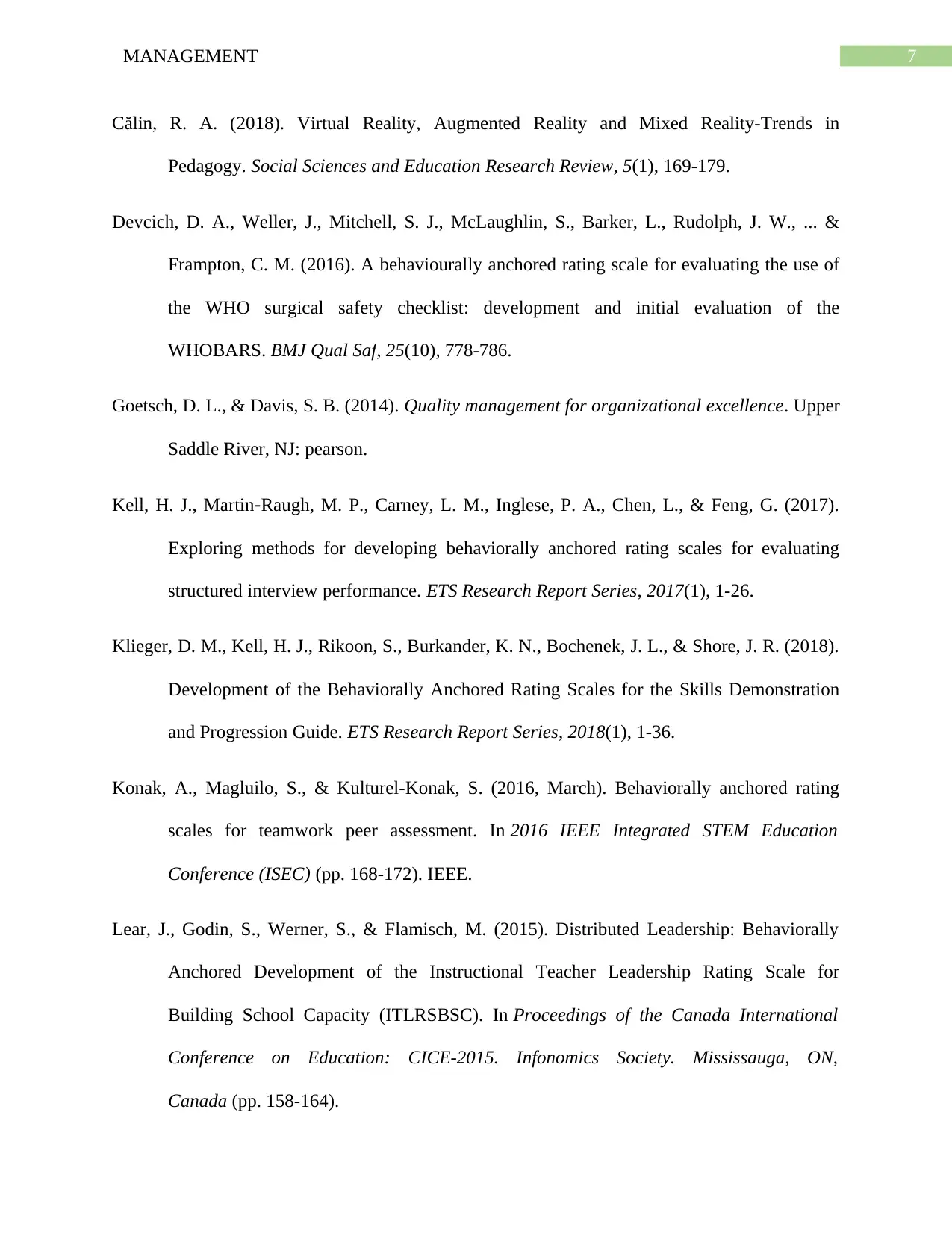
7MANAGEMENT
Călin, R. A. (2018). Virtual Reality, Augmented Reality and Mixed Reality-Trends in
Pedagogy. Social Sciences and Education Research Review, 5(1), 169-179.
Devcich, D. A., Weller, J., Mitchell, S. J., McLaughlin, S., Barker, L., Rudolph, J. W., ... &
Frampton, C. M. (2016). A behaviourally anchored rating scale for evaluating the use of
the WHO surgical safety checklist: development and initial evaluation of the
WHOBARS. BMJ Qual Saf, 25(10), 778-786.
Goetsch, D. L., & Davis, S. B. (2014). Quality management for organizational excellence. Upper
Saddle River, NJ: pearson.
Kell, H. J., Martin‐Raugh, M. P., Carney, L. M., Inglese, P. A., Chen, L., & Feng, G. (2017).
Exploring methods for developing behaviorally anchored rating scales for evaluating
structured interview performance. ETS Research Report Series, 2017(1), 1-26.
Klieger, D. M., Kell, H. J., Rikoon, S., Burkander, K. N., Bochenek, J. L., & Shore, J. R. (2018).
Development of the Behaviorally Anchored Rating Scales for the Skills Demonstration
and Progression Guide. ETS Research Report Series, 2018(1), 1-36.
Konak, A., Magluilo, S., & Kulturel-Konak, S. (2016, March). Behaviorally anchored rating
scales for teamwork peer assessment. In 2016 IEEE Integrated STEM Education
Conference (ISEC) (pp. 168-172). IEEE.
Lear, J., Godin, S., Werner, S., & Flamisch, M. (2015). Distributed Leadership: Behaviorally
Anchored Development of the Instructional Teacher Leadership Rating Scale for
Building School Capacity (ITLRSBSC). In Proceedings of the Canada International
Conference on Education: CICE-2015. Infonomics Society. Mississauga, ON,
Canada (pp. 158-164).
Călin, R. A. (2018). Virtual Reality, Augmented Reality and Mixed Reality-Trends in
Pedagogy. Social Sciences and Education Research Review, 5(1), 169-179.
Devcich, D. A., Weller, J., Mitchell, S. J., McLaughlin, S., Barker, L., Rudolph, J. W., ... &
Frampton, C. M. (2016). A behaviourally anchored rating scale for evaluating the use of
the WHO surgical safety checklist: development and initial evaluation of the
WHOBARS. BMJ Qual Saf, 25(10), 778-786.
Goetsch, D. L., & Davis, S. B. (2014). Quality management for organizational excellence. Upper
Saddle River, NJ: pearson.
Kell, H. J., Martin‐Raugh, M. P., Carney, L. M., Inglese, P. A., Chen, L., & Feng, G. (2017).
Exploring methods for developing behaviorally anchored rating scales for evaluating
structured interview performance. ETS Research Report Series, 2017(1), 1-26.
Klieger, D. M., Kell, H. J., Rikoon, S., Burkander, K. N., Bochenek, J. L., & Shore, J. R. (2018).
Development of the Behaviorally Anchored Rating Scales for the Skills Demonstration
and Progression Guide. ETS Research Report Series, 2018(1), 1-36.
Konak, A., Magluilo, S., & Kulturel-Konak, S. (2016, March). Behaviorally anchored rating
scales for teamwork peer assessment. In 2016 IEEE Integrated STEM Education
Conference (ISEC) (pp. 168-172). IEEE.
Lear, J., Godin, S., Werner, S., & Flamisch, M. (2015). Distributed Leadership: Behaviorally
Anchored Development of the Instructional Teacher Leadership Rating Scale for
Building School Capacity (ITLRSBSC). In Proceedings of the Canada International
Conference on Education: CICE-2015. Infonomics Society. Mississauga, ON,
Canada (pp. 158-164).
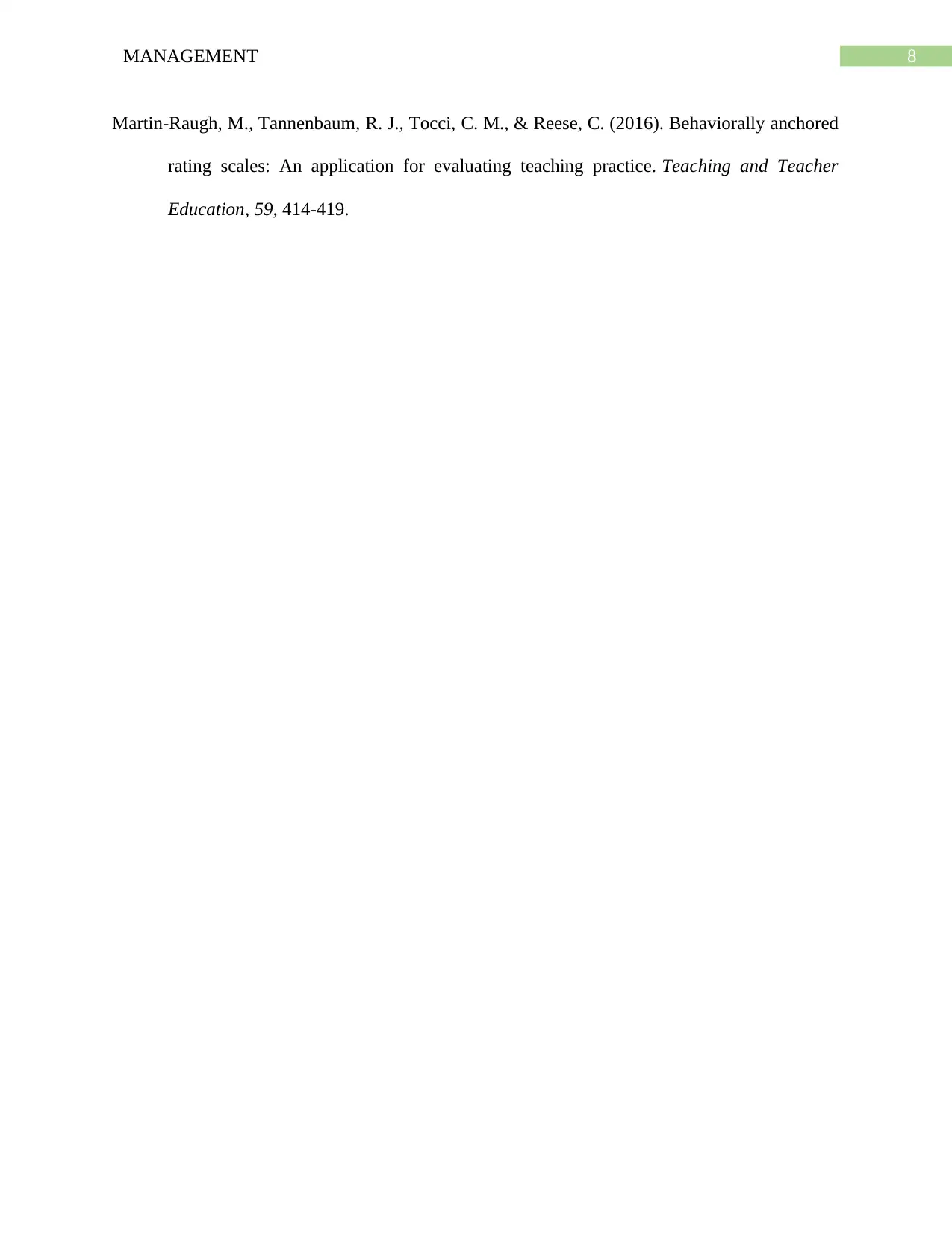
8MANAGEMENT
Martin-Raugh, M., Tannenbaum, R. J., Tocci, C. M., & Reese, C. (2016). Behaviorally anchored
rating scales: An application for evaluating teaching practice. Teaching and Teacher
Education, 59, 414-419.
Martin-Raugh, M., Tannenbaum, R. J., Tocci, C. M., & Reese, C. (2016). Behaviorally anchored
rating scales: An application for evaluating teaching practice. Teaching and Teacher
Education, 59, 414-419.
⊘ This is a preview!⊘
Do you want full access?
Subscribe today to unlock all pages.

Trusted by 1+ million students worldwide
1 out of 9
Related Documents
Your All-in-One AI-Powered Toolkit for Academic Success.
+13062052269
info@desklib.com
Available 24*7 on WhatsApp / Email
![[object Object]](/_next/static/media/star-bottom.7253800d.svg)
Unlock your academic potential
Copyright © 2020–2025 A2Z Services. All Rights Reserved. Developed and managed by ZUCOL.





